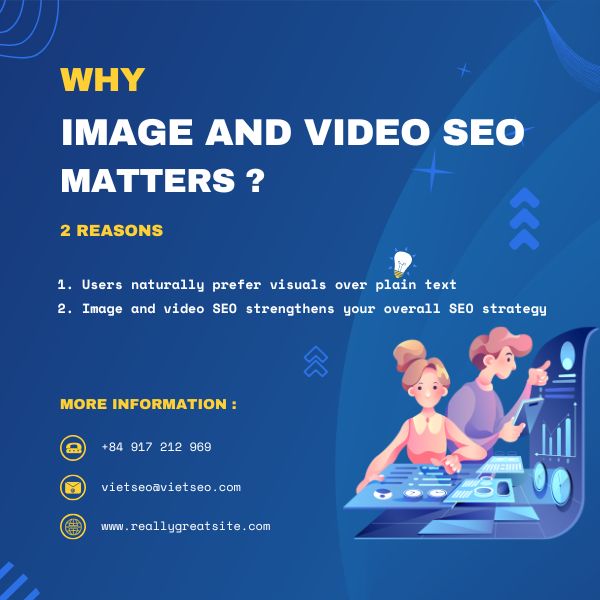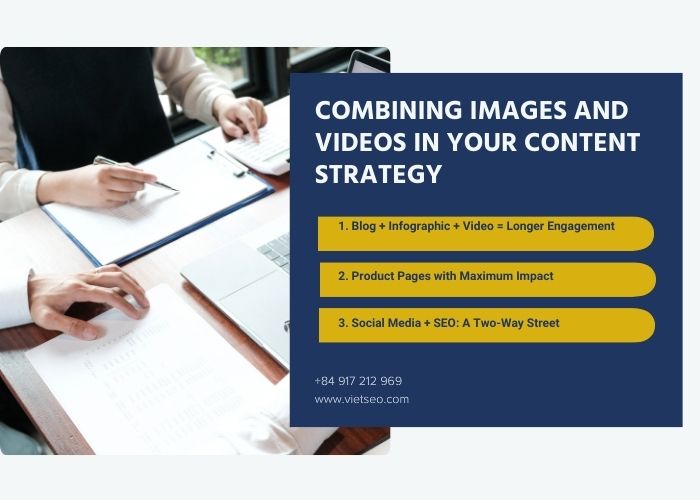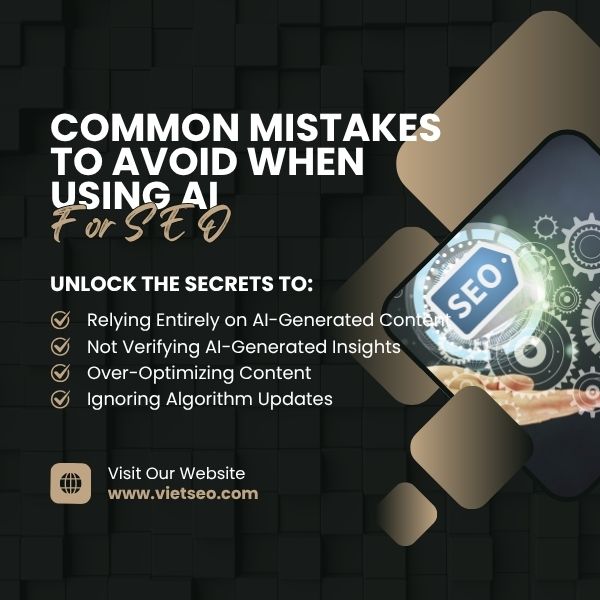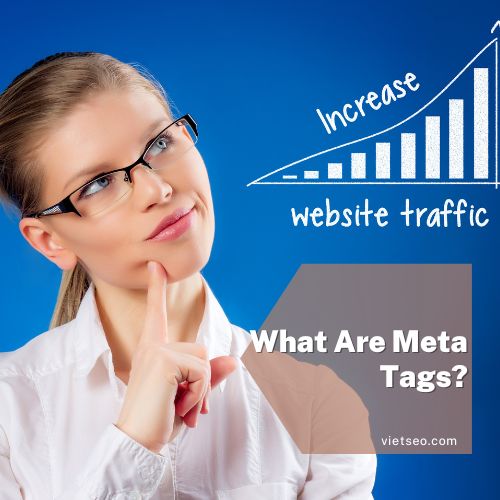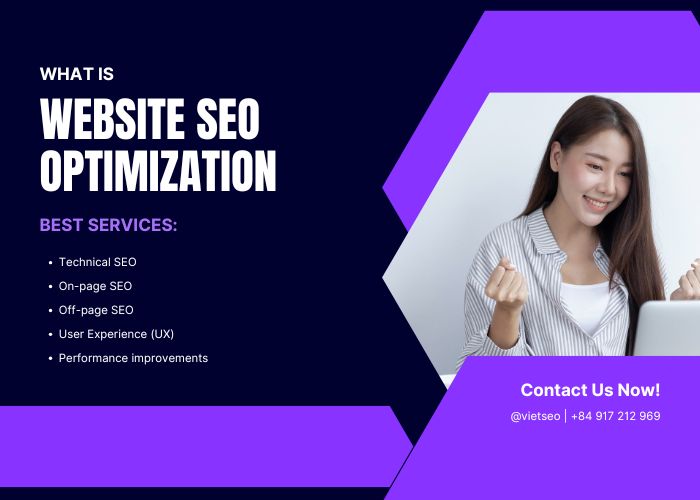Boost Rankings & Conversions with Comprehensive Image and Video SEO | Viet SEO
Image and video SEO doesn’t just make your website look better — it plays a direct role in how well your site performs on Google and how visitors interact with it. When optimized properly, multimedia content can improve your search visibility, speed up page loading, create a smoother user experience, and, most importantly, boost your conversion rates. The question is: how do you optimize your images and videos the right way? In this article, we’ll walk through the essentials and show you practical applications for different types of businesses.
Why image and video SEO matters more than ever?
1. Users naturally prefer visuals over plain text
Research confirms what most of us already know: people are drawn to visual content. A study by HubSpot found that:
- 72% of users would rather watch a video than read a written product description.
- Articles with relevant, high-quality images receive 94% more views than those without.
It’s not just about user preference either. Google itself has been giving more weight to images and videos in search results, especially on mobile devices where visual content often takes up prime space at the very top of the SERP (Search Engine Results Page).
Bottom line: if you’re not optimizing your images and videos, you’re leaving valuable real estate on Google’s first page to your competitors.
2. Image and video SEO strengthens your overall SEO strategy
Multimedia content doesn’t just help with visibility — it reinforces many of the core signals Google uses to rank websites:
- Lower bounce rates: A product demo video or explainer clip can hold a visitor’s attention longer, encouraging them to explore instead of leaving after a few seconds.
- Faster load speeds: Properly compressed and well-formatted images reduce page weight, which directly improves loading time — a ranking factor Google has publicly confirmed.
- More shareable content: People are far more likely to share engaging visuals or a short video than a wall of text. Every share increases your chances of earning backlinks, which strengthens your domain authority over time.
In other words, image and video SEO is not just “nice to have” — it’s a crucial part of modern search optimization and digital marketing. Without it, you risk lower rankings, weaker engagement, and fewer conversions.
Image SEO – Optimize not just for “looks” but also for rankings
Image SEO goes beyond making your website visually appealing. By properly naming files, adding alt text, compressing for speed, and using structured data, you ensure your images rank on Google Images and contribute to overall SEO performance. This means faster load times, better accessibility, more search visibility, and ultimately higher conversions.
1. Choose the right image format
Not all formats are created equal:
| Format | Advantages | Disadvantages |
|---|---|---|
| JPEG | Lightweight, easy to compress | Lossy quality |
| PNG | High quality, supports transparency | Large file size |
| WebP | Efficient compression, high quality, preferred by Google | Not fully supported on older browsers |
Recommendation: Prioritize WebP if your site aims for speed and SEO performance.
2. Optimize Image Filenames
Google doesn’t have eyes — it can’t literally “see” what’s inside your images. Instead, it relies on clues such as the filename and description tags to understand the content. That’s why giving your images meaningful names is one of the simplest but most effective steps in image SEO.
- Wrong example:
IMG002.png(generic, meaningless) - Better example:
thiet-bi-loc-nuoc-karofi-10-lit.png(descriptive, keyword-rich, useful to both Google and users)
Best practices for filenames:
- Always use lowercase letters.
- Avoid Vietnamese accents or special characters.
- Separate words with hyphens (-) instead of underscores or spaces.
- Make filenames descriptive and, when relevant, naturally include your target keyword.
Think of filenames as “labels” — the clearer and more relevant they are, the more likely your image will appear in Google Images and contribute positively to your overall SEO.
3. Add ALT Text (Alternative Text)
Alt text is a short description of an image that serves several important purposes. It’s not just a technical requirement — it improves both user experience and search visibility.
Why alt text matters:
- It supports visually impaired users who rely on screen readers to understand what’s on the page.
- It helps Google interpret the image content, which can boost rankings in image search.
- It shows up as fallback text when the image fails to load, ensuring users still get the context.
Tips for writing effective alt text:
- Keep it short and to the point — ideally under 125 characters.
- Be accurate and descriptive, focusing on what the image truly represents.
- Avoid keyword stuffing — one or two relevant terms are fine, but naturalness is key.
For example, instead of writing:
- ❌
"best water filter purifier buy cheap Karofi 10L sale HCMC"(spammy, keyword-stuffed)
You should write:
- ✅
"Karofi 10-liter water purifier with multi-stage filter"(clear, concise, relevant)
Alt text is one of those small details that many sites overlook, but when done right, it significantly improves both accessibility and SEO performance.
4. Compress Images Without Sacrificing Quality
One of the biggest reasons websites load slowly is oversized images. Google has made it clear that page speed is a ranking factor, and since images usually account for the majority of a page’s weight, proper compression is critical.
The good news? You don’t need to compromise on quality. Modern compression tools can reduce file sizes by 50–70% while keeping the image sharp and clear.
Recommended tools:
- Online: TinyPNG, Squoosh
- Mac users: ImageOptim
- WordPress plugins: ShortPixel, Smush, EWWW
By running your images through these tools, you can maintain high visual quality while ensuring your pages load quickly across all devices — especially important for mobile users on slower connections.
5. Use Lazy Loading for Faster Initial Page Speed
Even if your images are compressed, loading them all at once can still slow down the first paint of your website. That’s where lazy loading comes in.
With lazy loading, images are loaded only when the user scrolls down to them, instead of all at once when the page first opens. This dramatically improves the initial loading experience and makes your site feel faster.
How to implement lazy loading:
- Add the attribute to your
<img alt="" src="">tags (simple and effective). - If you’re on a CMS like WordPress or Shopify, use a plugin or built-in option that automatically applies lazy loading to all images.
This small adjustment not only speeds up your site but also helps reduce unnecessary bandwidth usage, which is especially beneficial for users on mobile networks.
Video SEO – Optimize to Dominate Both Google and YouTube
1. Video SEO Isn’t Just About YouTube
When people think of video SEO, they usually picture YouTube. While YouTube is essential, video SEO extends far beyond it. If you embed videos correctly, Google can index them directly from your website. This means your videos can show up in:
- Google Video results
- Google Images
- Google Discover feeds
So, instead of limiting your strategy to YouTube alone, you should optimize videos for both platforms:
- YouTube: to build reach and community engagement.
- Your website: to boost organic rankings and conversions directly from search.
2. What Elements Should Be Optimized?
To give your videos the best chance of ranking, focus on these key areas:
- Filename: Like images, your video file should be descriptive and keyword-rich (e.g.,
water-purifier-installation-tutorial.mp4). - Metadata: Use a clear, keyword-optimized title, description, and tags. These act like your video’s “SEO packaging.”
- Video schema (structured data): Adding schema markup helps Google understand the video content and display rich snippets (like video previews or timestamps).
- Thumbnail: Choose a high-quality, relevant thumbnail. A good thumbnail not only improves click-through rates but also gives Google context about the video.
- Transcript: Providing a full transcript makes your content searchable, boosts accessibility, and gives Google more text to crawl.
3. Make Sure Your Video Solves the Right Problem
Search engines value engagement signals. If users click on your video but leave after a few seconds, it can hurt your rankings. That’s why relevance and structure are so important.
Recommended video structure:
- First 5 seconds: Hook the viewer’s attention immediately (with a question, bold statement, or visual cue).
- Main body: Deliver the promised value clearly and concisely.
- Ending: Include a strong call-to-action (CTA), whether it’s subscribing, visiting your site, or checking out a product.
Remember: Google and YouTube both consider watch time and audience retention as ranking signals. The more your video keeps people watching, the better it will rank.
4. Optimizing Videos on YouTube
Since YouTube is the second-largest search engine in the world, every video you upload should be treated like a complete SEO content piece. Here’s the checklist:
- Title: Use your main keyword naturally. Keep it within 60–70 characters for best visibility.
- Description: Write at least 250 characters, include target keywords, timestamps for easier navigation, and add relevant website links.
- Hashtags: Add hashtags that reflect your industry, product, or trending topics.
- Tags: Use supporting keywords that complement your main topic.
- Playlists: Group related videos into playlists. This increases session watch time and signals authority on a specific topic.
Done correctly, video SEO allows you to dominate two search engines at once: Google and YouTube. That means more visibility, more clicks, and more conversions.
Combining Images and Videos in Your Content Strategy
Optimizing images and videos separately is powerful, but the real magic happens when you combine them into a single, well-planned content strategy. Together, they not only improve SEO performance but also enhance user engagement and drive higher conversions.
1. Blog + Infographic + Video = Longer Engagement
A blog post enriched with visuals and multimedia keeps readers on your site far longer than text alone. The ideal structure looks like this:
- 1–2 relevant images that illustrate key points.
- 1 infographic that summarizes the article in a visual, easy-to-digest format.
- 1 explainer video that provides more depth or demonstrates a process.
When used together, these elements can increase average time on site by 2–3 times. The result? Stronger SEO rankings and a much higher chance of converting readers into leads or customers.
2. Product Pages with Maximum Impact
For e-commerce and service websites, visuals often make or break the sale. An optimized product page should include:
- High-quality images from multiple angles, showing details clearly.
- Demo or unboxing videos that help potential buyers visualize the product in action.
- Customer review videos that provide authentic social proof.
This mix of content doesn’t just boost SEO — it builds trust, reduces return rates, and significantly increases purchase intent.
3. Social Media + SEO: A Two-Way Street
Images and videos aren’t limited to your website. They’re highly shareable and can fuel a multichannel strategy:
- Videos shared on Facebook, TikTok, or YouTube Shorts can attract attention and generate backlinks to your site.
- Blog post images can be repurposed for Instagram or Pinterest, driving traffic back to your article.
By reusing and repurposing your visuals across platforms, you maximize exposure while reinforcing your SEO efforts. A multichannel content strategy is one of the fastest ways to leverage the full power of image and video SEO.
Common Mistakes in Image and Video SEO
Even with the best intentions, many businesses fall into the same traps when trying to optimize their multimedia content. Avoiding these mistakes can save you time, protect your rankings, and improve overall performance.
- Uploading oversized image files: Heavy, uncompressed images slow down your site, which frustrates users and signals to Google that your website isn’t optimized. Always compress before uploading.
- Ignoring or misusing alt text: Some sites skip alt text altogether, while others overload it with keywords. Both approaches hurt SEO and accessibility. The goal is simple, descriptive text that accurately represents the image.
- Embedding videos without transcripts or schema: A video alone isn’t enough. Without a transcript, search engines can’t fully “read” your content. Without schema markup, you lose the chance for rich snippets in search results.
- Relying on irrelevant stock videos: Generic or unrelated stock footage may fill space, but it doesn’t build trust. Audiences connect far more with original, brand-specific content.
- Focusing only on YouTube SEO: Many brands optimize their YouTube channel but forget to link back to their website. This means you’re giving traffic to YouTube instead of driving visitors where conversions actually happen.
By being aware of these pitfalls — and proactively addressing them — you can ensure that your image and video SEO efforts truly enhance visibility, user experience, and conversions.
Images & Videos Are SEO Assets – Not Just Decoration
In today’s highly competitive digital landscape, relying on plain text alone is no longer enough to capture attention or persuade users to take action. People expect engaging, dynamic experiences — and that’s where images and videos play a vital role.
Optimized visuals allow you to tell stories in a way words can’t, demonstrate products or services in action, and create an emotional connection that keeps visitors on your site longer. A compelling product demo video or a well-designed infographic can often explain in seconds what paragraphs of text cannot.
The key is to stop treating visuals as mere decoration. Every image and video you produce should be considered a strategic digital asset. When optimized correctly, they do far more than make your site look attractive:
- They increase your visibility on Google through image search and video snippets.
- They strengthen user trust and engagement.
- They directly support conversions, helping you sell more — without depending solely on paid ads.
In short, image and video SEO isn’t just about aesthetics; it’s about turning content into assets that continuously generate value for your business.
